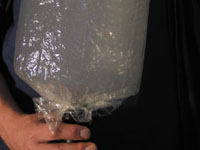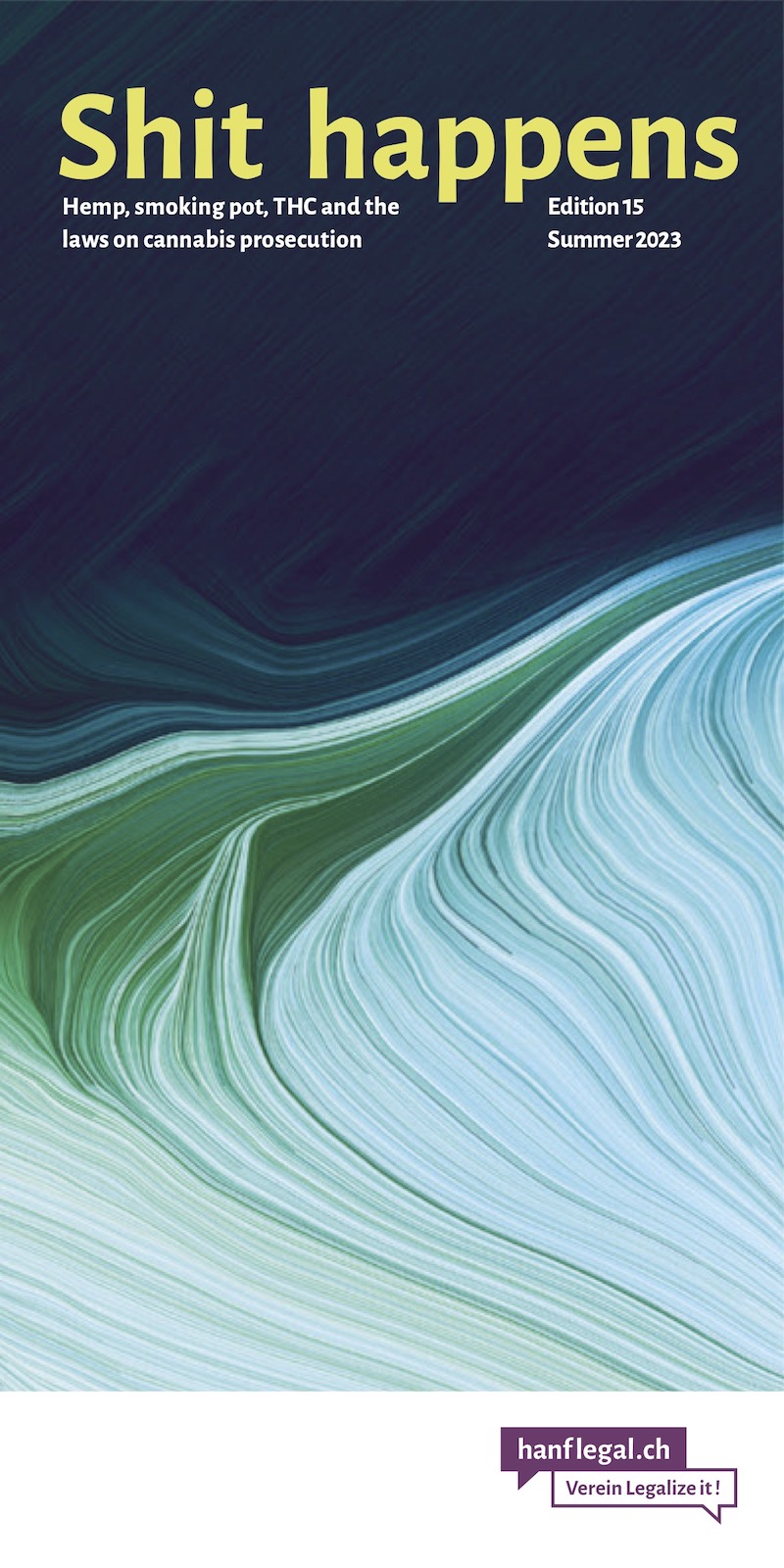- THC & Law:
vaporize instead of smoking - what makes vapor healthier?
We have reviewed a study that examined hemp smoke and hempvapor and compared the different ingredients. Why vaporize is more efficient and massively less harmful than smoking is explained in our article.
Basics
For an introduction to the topic of vaporization, three articles that we have printed in previous issues of Legalize it! are suitable. In the article “Vaporizing instead of smoking - the new pleasure” we described the technical basics of vaporizing and compared it with the processes in a joint (Legalize it! 27, pages 11-13). In the article “Overview of three vaporizers” we conducted a small test with different vaporizers that are on the market (Legalize it! 28, pages 11-13). Regarding the substances contained in cannabis, the article “Trans, levo isomer of delta-9-tetra-hydro-cannabinol” in Legalize it! 29, pages 4-5, is recommended.
Result of the self-testing
If you really want to get stoned again and you do it with joints, you can definitely feel it in your lungs the next morning. The strain is there, no question. However, if you have such a stoned evening and vaporize and inhale THC instead of smoking, you will hardly notice any impairment of lung function the next morning. Furthermore, one needs less hemp flowers for the same stoned state. This is the assessment of many stoners, including myself. But it is not so easy to put this subjective feeling into scientific criteria.
The original study
The study we will discuss here was conducted in 2003, is 55 pages long and is titled “Evaluation Of Volcano® Vaporizer For The Efficient Emission Of THC, CBD, CBN And The Significant Reduction And/Or Elimination Of Polynuclear-Aromatic (PNA) Analytes Resultant Of Pyrolysis”. So, the first is to find out how efficiently THC is released by vaporization and the second is to determine the presence of polyaromatic hydrocarbons (PAHs) (these are specifically problematic because they are carcinogenic and are produced primarily by incomplete combustion). The original study was commissioned by the MAPS and NORML organizations in the U.S. - two organizations that seek to study psychedelic issues and change cannabis laws, respectively.
How did we investigate the study?
First I read the extensive study a few times, discussed it with a natural scientist and then we commissioned the Institute IOS3 in Bern with a small study about this study, so that we were really sure to understand the essential parts and to be able to assess their quality. Furthermore, in this article we include our, admittedly subjective, but concrete vapor experiences that we have gained with vaporizing for over a year now. However, we always point out whether a result comes from the study or from ourselves.
Which evaporator was examined?
The authors of the study first examined various vaporization devices and came to the same conclusion as we did at Legalize it! 27, concluded that the Volcano was the most sophisticated device currently on the market (and also the one we use most often). The Volcano pumps air through holes in a piece of metal that has been heated to the desired temperature (around 200 degrees Celsius). The warm air flows through the weed and the resulting vapor is collected in a balloon and can then be consumed.
How did the study go about investigating THC?
A portion of hemp herb was divided into different parts of equal size and thus examined in three different ways. Firstly, the THC content of the substance itself, secondly, the THC yield during combustion and thirdly, the THC yield during vaporization were each measured in several runs.
1) The extraction was performed as follows. Several portions of weed were treated with ethanol (a solvent) and the resulting solutions were then analyzed for their constituents. This was probably able to dissolve pretty much all THC from the sample material.
2) Combustion was performed as follows. Several portions of weed were dissolved into smoke in a special machine that heated the weed to over 230 degrees Celsius (causing the weed to ignite itself). Then this smoke was dissolved in methanol (a solvent) and analyzed for its constituents. Nothing was left behind by this procedure (except ash) - so all the material was destroyed. In relation to smoking, this experimental arrangement has of course a crucial difference: If you smoke weed pure in a joint, you can never inhale all the smoke produced - a large part pulls away from the joint, if you do not pull and especially if you stop pulling.
3) Vaporization was done with the Volcano, as mentioned. Several portions of weed were heated three times each with the Volcano and the vapor thus produced was collected and again dissolved with methanol and analyzed for the ingredients. Of course, there is still material left over, because evaporation does not destroy all the material used, but merely dissolves a small portion of the total mass into a gaseous phase. Unfortunately, the remaining material was not further examined in this study (although further THC can of course be found in it - in any case, in self-experiments, we find that even after the fifth heating process, incoming THC is still dissolved).
THC yield efficiency comparison
If the weed was treated with ethanol to dissolve the THC, the results gave an average of 4.15 percent THC. Thus, it can be said that the weed used in all three experiments has a (rather low) content of about 4 percent THC. (Good weed has 10 to 20 percent THC.) So now that the basic value for the weed had been established, it was possible to compare this with the values for combustion and vaporization. For vapor a value of 1.95 percent THC was found, for burning one of 3.24 percent THC. So, if the 4 percent THC represents the maximum, i.e. 100 percent, complete combustion managed to get about 80 percent of the THC out of the material (the rest was destroyed by the heat), while vaporize dissolved about 50 percent of the THC.
What does this result mean in practice?
Anyone who smokes must therefore always reckon with a basic loss of 20 percent THC. In addition, there is the loss caused by the smoke drifting away. Here, the type of consumption probably has a decisive effect on the efficiency of the absorption of THC. Unfortunately, the study was not able to determine this loss. The 80 percent found in the laboratory would only be usable if all smoke were inhaled, but this is impossible with joint smoking. We assume that about half of the THC disappears in the smoke, and half reaches the lungs. Calculated in this way, the yield under real conditions would be about 40 percent. In the case of vaporization, as mentioned above, 50 percent yield is achieved after three heating cycles. Unfortunately, the study did not provide exact information on how much THC each vaporization pass dissolved (three vaporizations were performed and then all vapor was examined together). From our vaporization experience, we would estimate that the first balloon/heating pass released about 20 percent, the second then 15 percent, the third perhaps another 15 percent, the fourth still about 10 percent, the fifth also 10 percent, the sixth and the following then under 10 percent each. Up to the third balloon it is very fine, then the quality of the taste slowly decreases. From there, one can make four to seven passes in practical use, which should dissolve over two-thirds, or 70 percent, of the THC present. This is also confirmed by the impression that the same amount vaporized goes in stronger than when smoked. But on the whole, it can be said that in the end, in the consumer, there are losses of THC in both smoking and vaporizing. (Actually, only eating is imaginable without losses. Those who eat cannabis should have the best utilization, because all THC enters the body). However, losses are likely to be greater with smoking than with vaporizing. We would say the vaporize seems about twice as efficient. But the biggest difference between vaporize and smoking is not primarily in efficiency, but in the ingredients.
Semi-quantitative study
In a second step, it was now investigated which other substances (besides THC) can be found in vapor, respectively in the smoke. In the analyses of the vapor, the study authors found that the THC and other cannabinoids make up about 95 to 98 percent of the vapor. The rest is partly (about 1 percent) caryophyllene (a flavoring agent), and one to two polyaromatic hydrocarbons (PAHs) were found (about 2 to 4 percent). These substances can cause cancer and are problematic. The cannabinoids, on the other hand, do not cause any health problems as far as is known today (they simply go to sleep), but the flavoring agent caryophyllene can irritate the lungs (which is also noticeable when smoking strong-smelling cannabis). But just: the vast majority of the vapor is simply THC, the problematic substances are only found on the periphery. The ratio of cannabinoids to the rest is between 98:2 and 95:5 at vaporize. This means that the largest part of the vapor is certainly unproblematic. On the other hand, it is also not completely harmless. In the smoke, on the other hand, the researchers found about 12 percent cannabinoids, about 0.75 percent caryophyllene, and all the rest consisted mainly of various PAHs. More than 100 (!) different problematic substances were found - substances that do not contribute anything to driving in, but can pollute the lungs and cause cancer. The ratio of cannabinoids to the rest is about 12:88 when smoking. This ratio is practically the opposite of vaporize. (By the way: Since only weed pure was tested here, the normal joint smoker, who mixes cannabis with tobacco, also has to deal with other substances that only occur in tobacco: above all nicotine. The PAHs, however, are of course very similar - whether you smoke weed, tobacco or anything else, such substances are always released).
Summary
The IO3S writes in its final report on this study: “The study is certainly useful for qualitative statements; i.e. to prove that practically no combustion substances are produced.” The exact quantification of the ingredients, however, has not been convincingly solved, it says. “As for the carcinogenic effect, it will certainly be several hundred times lower, but also some substances naturally occurring in the plant (e.g., some aromatic substances) can be carcinogenic in excessive doses. What has been proven for sure is that far fewer problematic substances are ingested.” It is also likely that higher amounts of THC would be ingested. However, this could not be clearly proven by this study.
Test evaporator
For those who would like to see a vaporizer up close and test it, we offer the following. In our office we have four vaporizers: the Volcano (with which the study described here was conducted), the Element, the Vapir and an older model of the Aromed. You should be able to spare a few hours and be in Zurich on a Friday. From 4pm to 9pm we can make an appointment and show you the devices. We find vaporizing a very good alternative to smoking. Taste-wise, vaporizing is unsurpassable, the break-in is strong and clear. You need less material than smoking. But the main advantage is the stanklessness: even if you vaporized a whole evening in a closed room, it does not stink in any way. Even blatant smoke haters can't detect any emissions by any stretch of the imagination (vaporizers, however, can very much detect the effects of THC in their brains). This makes vaporizing ideal for small apartments, or in places where non-smokers and smokers (have to) live together. The only disadvantage of vaporizing is the initial cost of such a device. 500 to 800 francs should be budgeted (there are also bad or even non-functioning “vaporizers”). But the price is quickly recovered by the higher efficiency. And the taste is priceless!
Support our work with a donation:
Bank transfer
Account number (IBAN):
CH02 0900 0000 8709 1354 3
Full account details
Or scan this QR code with your eBanking App (ZKB, Revolut, Postfinance, …):

Or open/share the QR code as PDF file with your eBanking App.
Credit card
Donate via credit card
Verein Legalize it!
Quellenstrasse 25
8005 Zürich
Threema ID 7NH65RBY
Don’t miss anything! Follow us on social media:

